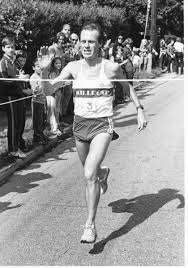December 8, 2013
Dr. Norbert Sander is the very type of gracefully-aging athlete that every older runner wants to be: bursting with energy, fully animated, articulate, and armed with an engaging personality. But there is more to Dr. Sander than just a great first impression – much more. Sander – an accomplished physician in his own right – has blossomed forth in the later stages of his professional life as a primary architect of the rebirth of track & field – particularly the indoor variety – in the greater New York area.
Sander – who grew up in Yonkers – has lived his entire life in the NYC metropolitan area. While at Fordham Prep and Fordham University, Sander fell in love with running while competing in track & field. After medical school, the good doctor went into private practice as a pediatric physician – eventually running two successful New York medical offices. But Sander still made time for his running – even winning the 1974 New York City Marathon in 2:26:30 – an impressive time over the hilly multi-lap course in Central Park.
Dr. Norb Sander racing New York City Marathon in 1974, from
the armorytrack.com
But the late 80’s brought an experience that would forever change the direction of Sander’s life – and would ultimately help a New York neighborhood avert what appeared to be inevitable further decay. “Twenty years ago, I was in my office and a patient came in and asked, ‘Do you know anybody who could help us get back into the Armory,'” the doctor reflects. Sander knew the fabled Armory well. Built in 1909, the Armory had been the site of performances by virtually all of the great track & field performers – from Paavo Nurmi forward. The Armory’s record-conducive facility also had produced an abundance of pinnacle performances – ranging from high school bests to world records. But Sander also knew that the grand facility had succumbed to an absence of focused leadership, a lack of funds, and flat-out neglect. “At the time, the Armory served as a shelter for 2000 homeless people. It got so chaotic and out of control track & field had to leave. We had no track. And the sport was completely in decline because of this.”
Sander – never one to back away from a challenge – started to think about his patient’s inquiry – writing letters, meeting with city leaders. “You couldn’t get into the Armory – even just to look at it. It was dangerous,” notes Sander alluding to the then-present drug trafficking and related crimes that were rampant in Washington Heights. “Those affiliated with the Armory were afraid that someone in the press would write an expose about the place. When we finally got into the Armory, every window was broken, the ceiling was black, and there were no lights. Most of the seats were missing,” explains Sander. “The state once owned the Armory. But it was in such bad shape that the state handed it to the City for a dollar. Really, the building was a wreck.”
Sander immediately saw the need and knew what had to be done. But could he realistically lead the massive rehabilitative effort that would be necessary to rejuvenate the dilapidated facility at Broadway and West 168th Street? “At the time I was maintaining two pediatric offices. I was under a tremendous amount of stress. I ended up running the newly-created Armory Foundation out of my office,” explains Sander of the early days of emerging community effort to save the tarnished jewel of Washington Heights. “Ultimately, we needed an Executive Director, a CEO. And I thought, ‘Geez, I got this far – ten years into this thing. I kinda know it better than anybody.’ Plus, we weren’t there yet – we had a lot to do. So I put my name forward and I became the CEO.” Just like that, Norbert Sander was all in: he was heading up a growing, neighborhood effort calculated to rescue the Armory – and the community of Washington Heights as well. “I closed my Manhattan office,” offers Sander on the career changes his new direction required. “But I kept my office on City Island. Now I go there twice a week. But I also have a younger guy who is running the office.” And with a smile, he adds, “No worries.”
“When I first came here in 1990, this neighborhood was a very dangerous place. We had a lot of crime up here,” Sander reveals in explaining magnitude of the challenge he then faced. “It took 3 years of lobbying. But we dedicated the new track in October in 1993. The City handed me the key and said, ‘Go to it.'” And with zest, Sander adds, “This is our 20th season.”
To view the gleaming facility that is the Armory today, it is hard to believe that 30 years ago the oversized building was a decaying eyesore that served as a homeless shelter – a place where ragtag track meets were held in a neglected and ravaged structure and where impoverished individuals sought refuge from the mean streets of Washington Heights. The track facility is stunning – featuring a brand new 200 meter banked Mondo track surrounded by intimate, elevated seating for 3500. “We seat 5000 for the Millrose Games because we bring in temporary seating on the turns,” notes the Executive Director. “For the New Balance Games for high school, we get 5000 kids participating in the event. Sometimes there is no room for the parents.” Sander takes obvious pride in pointing out a sparkling new trackside café, an adjacent glass-enclosed communication center for the media, even a retail store selling Armory-labeled track & field merchandise. “It’s a nifty place,” he adds with a smile.
Every little detail counts for Sander – even the 4-story stairwell replete with plaques displaying the names, dates, events, times, heights and distances of every record-setting Armory performance. “These are all records – every one of these is a record that was set in this building – high school, American, and World records,” he notes gesturing toward these little visual kernels of track & field lore and inspiration for those who come here to compete and to spectate.
20 years after its rebirth, the Armory is still evolving as ongoing renovation continues to transform the massive old military facility. “We’ve got a ways to go here, but we’re getting there,” says Sander as enters a museum-like display room. “These are going to be display cases – each with a different theme. One will be dedicated to the Penn Relays, another will be for the Pioneer Club, New York Road Runners, et cetera,” he explains. “We have all kinds of memorabilia, videos, and other items we have collected. So this will be an archive for this museum.”
Even beyond its function as a premiere track & field facility, the Armory also is the home of the National Track and Field Hall of Fame. The names of all of the inductees into Hall are prominently displayed – and categorized by events.
The Armory also serves as a museum – a veritable archival repository for track & field memorabilia: Steve Prefontaine’s track shoes and Oregon singlet; a Tigerbelle’s warm-up top; video clips of Dave Wottle’s stirring stretch drive for Olympic gold in the 1972 800 final; black and white photos of a youthful Wilma Rudolph at the Millrose Games – it’s all there. Hockey great Mark Messier – intent on transforming the Bronx’s Kingbridge Armory into a national ice center – recently visited the rejuvenated Armory seeking ideas and inspiration. “You know what is great about this?,” Messier marveled. “Every time you turn around, you see a little piece of history. We’ve got to do this for hockey.”
The type of breath-taking transformation that has occurred at the Armory requires capital – and plenty of it. Over the years, Sander has been quite successful in marshaling the economic support to fuel the still-ongoing renovation of the Armory – raising more than $25 million from public and private sources since 1993. “We get money from wherever we can find it. I get it from the City. New Balance helps us a lot. The New York Road Runners provides assistance. We also have a good financial planner,” notes Sander.
The primary focus of the Armory’s renaissance is track & field. But Sander – a realist – knew that a successful, fiscally-sound Armory would require a multi-use vision. “In order to support track, I have to do other things. I don’t want to leave a void here. I want to have something going on all the time here,” explains Sander in outlining how the facility is also used for other events such as Columbia University commencement exercises, trade expos, corporate conferences, even movie shoots. “The City gave us this building for track. But we have to keep the entire community happy,” he notes.
“It is hard to get money for track. If you tell people the funds will go just for track & field, you can’t get the money,” confides Sander. But over time, the Executive Director of The Armory Foundation has discovered a much more effective approach to fundraising. “If you merge the request around track and education, that’s a different story. If you show that this sport takes you somewhere – that you’re not just running in circles – and that you can take the discipline, the mentoring from your coach, and you can put that together with an education, that’s what people want to see.” One such funded initiative – Classroom 2 Everywhere – is a marquee Armory-based program assisting over 300 New York high school students. “To get in this program, you have to be on the track team. You can come from any place in the city – Brooklyn, Staten Island. They come here to the Armory on Tuesday and Thursdays, they take their workout, and then they do SAT prep or financial planning. We go over their college applications. Sometimes we take them on bus trips of colleges. And we get nearly 100 percent into some college,” beams Sander.
23 years after Norbert Sander’s initial visit to the 168th Street Armory – and after years of unrelenting focus and loving restoration – the Armory now stands as the rejuvenated hub of Washington Heights. Promoting excellence, fitness and community, the Armory hosts more than 100 track events each year, maintains the National Track and Field Hall of Fame, operates the largest after-school activity center in New York, and offers a variety of community support program in what is now recognized as a world class facility. The Armory is so much more than simply a state-of-the-art-facility for indoor track & field, a shrine to the sport. It is mute testimony of what even just a single visionary can accomplish when supported by an inspired neighborhood and indeed the entire metropolitan area. The Armory is now an active, bustling community center which pays reverence to yesteryear – and also fosters hope for tomorrow. “As we stand here behind this wall, we are viewing the past,” explains Sander looking at the clear, translucent Plexiglas wall displaying the names of all of the inductees into the National Track and Field Hall of Fame. “But we can also look through that wall out onto the track to see the youth, the kids running. That’s our future.” Dave Hunter
Author

Dave Hunter is an award-winning journalist who is a U.S. Correspondent for Track & Field News. He also writes a weekly column and serves as Senior Writer for www.RunBlogRun.com, and covers championship track & field competition domestically and in such global capitals as Moscow, Birmingham, Zurich, Brussels, Beijing, Rio de Janeiro, Zagreb, Ostrava, and Doha. Hunter frequently serves as the arena or stadium announcer for championship track & field gatherings, including the Ivy League, the Big East, the Mid-American Conference, the NAIA, the Big Ten, and the Millrose Games. Hunter has undertaken foreign and domestic broadcast assignments. He ran his marathon P.R. 2:31:40 on the Boston Marathon course back in the Paleozoic Era. To find out more about Dave, visit his website: www.trackandfieldhunter.com He can be reached at: dave@trackandfieldhunter.com
View all posts




















